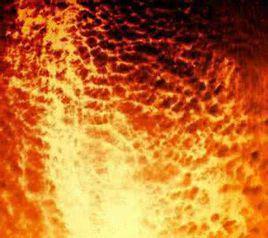Magma refers to the underground or partially melted rock. When magma erupts out of the earth's surface, it is called Lava. Magma generally consists of liquids formed by melting, minerals crystallized from liquids, xenoliths and inclusions, and gases dissolved in magma.

Lava refers to magma ejected from the earth's surface, it is also used to represent rocks formed by the cooling lava, the fluidity of molten lava decreases with the increase of silica, the viscosity of basic lava is small and it is easy to flow, while that of acidic lava is not. Lava can take many forms depending on its chemical composition or volcanic environment.
(1)Lava flowing in liquid form on the surface is called lava flow, which is sometimes called lava flow after cooling to form solid rock accumulation. The temperature of lava flowing in liquid state is usually between 900°〜1200°C, if there is more gas in lava, lower temperature can also flow. Acid Lava is viscous and does not flow far away, large area of lava flow is usually basic lava. When the temperature is high and the slope is steep, the velocity of lava flow can reach 65km/h. The shape of lava flow depends on many aspects, such as lava composition (basalt, Anshan rock, dacite, rhyolite), flow rate, topography and environment.
(2)Round, steep-edged mounds are formed when high-viscous volcanic lava (dacite or rhyolite) blocks the vents. The top of the lava dome usually has no crater, and the magma coming from the ground squeezes into the interior of the lava dome, thus causing the deformation of the lava dome bulge. The surface of the lava dome is hard, cooled lava, so when the deep magma continues to squeeze , the lava dome will explode and form a crater of debris.
(3)Lava Tube and Lava Tube Caves. Lava tube is a tube formed naturally inside lava flow. When the liquid lava flows, the solid crust is formed due to the rapid cooling of the surface, under the heat preservation of the surface crust, the internal temperature is high and the flow velocity is fast, thus forming a tube. A large lava flow often has a main tube and several small branches. When the volcanic eruption is over, the supply of lava stops, or the upstream lava flow turns, and the lava in the lava tube continues to flow downward, thus forming an empty lava tube caves. Generally, the lava tube caves is emptied with flat bottom and usually suspended with lava stalactites at the top. The existence of lava tubes increases the velocity and distance of lava flow. Early lava tube caves may be used by later lava flows.
(4)Slag lava (aa). "aa" is a Hawaiian word, pronounced "a,a", used to describe surface roughness lava flows. This flow of lava is filled with porous and prickly fragments of lava, known as "slag". The reason of slag lava is that in the process of lava flow, the surface lava ceaselessly solidifies, and the consolidated surface brittle fracture occurs continuously along with the flow of lava, forming "slag block", "slag block" and liquid lava rolling over and bonding, forming a flower - like shape. Therefore, slag lava is also called flower - like lava.
(5)Pahoehoe. "Pahoehoe" is a Hawaiian word used to describe a molten rock with a smooth surface. This kind of lava is sometimes dome-shaped or rope-shaped, also known as rope-shaped lava. In the process of crust lava flow, the surface cools to form a plastic crust, and the lava flow inside constantly extrudes to form a new crust. Crustal lava is often described as a lava sculpture with strange shapes. The crust lava has low viscosity, easy to flow, and less pores on the surface of lava flow.
(6)Pillow Lava. It is formed by volcanoes erupting underwater, which is round and looks like pillows stacked together. When lava flows out of the water, rapid cooling causes a tough solid crust on the surface of the lava flow. As the internal pressure of the lava flow increases, the crust breaks down, squeezing out new lava like toothpaste, and then forming the crust again. In such circulation, pillow lava is produced.
The material ejected from volcanoes mainly includes lava flow, volcanic debris flow and volcanic ash.

Comment list ( 0 )
